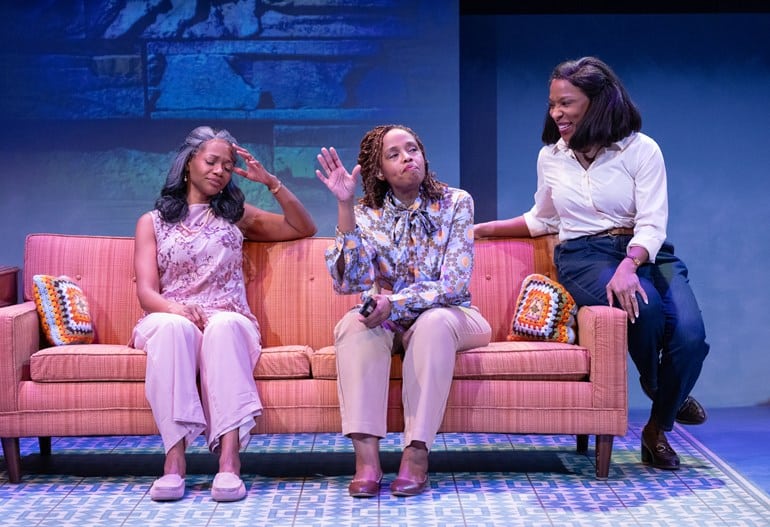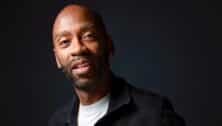People’s Light Leigh Jackson Conducts Interview with Jerrilyn Lanier Duckworth, Wig & Costume Designer

Jerrilyn Lanier Duckworth designed the wigs and costumes for the ripple, the wave that carried me home, the new People’s Light production about the daughter of prominent activists in the movement to desegregate local swimming pools. This powerful play, written by Christina Anderson and directed by Donya K. Washington, runs at People’s Light from Feb. 21 through Mar. 24.
Duckworth recently sat down with Leigh Jackson, Director of Inclusion, Diversity, Equity & Accessibility Programming at People’s Light, to discuss Black hair and the significance of wigs in the production.
_________
Jackson: Can you envision this play with actors who are not wearing wigs? Is that possible?
Duckworth: Wigs are so important to this play. The story is about time, so you can’t tell the story without the change in hairstyles — and you can’t have the change in hairstyles without the wigs.
Jackson: How many wigs will you need for this production?
Duckworth: Ten in total. Four for Helen. Five for the actor playing both Aunt Gayle and Young Chipper. And one for Janice. It does add up.
Jackson: Why are wigs so expensive?
Duckworth: There are so many variables. Length, color, and texture play heavily into the cost. Wigs can come in synthetic hair, human hair blends, and virgin human hair. They can come with lace fronts and hard fronts. The lace fronts look more natural. And there are different types of lace, such as illusion lace, which disappears. When I looked at the Haas theatre (where the play will be staged), I thought I would need illusion lace so the hair could look believable underneath those lights. I shop as carefully as I can, sourcing out wigs from different places. Helen’s short wigs are the most expensive, because of their sophisticated look. They really are the styles of someone who goes to the hairdresser regularly.
Jackson: Is there anything else that contributes to the cost?
Duckworth: Care is important. I have to consider whether the performer sweats and how often the wigs need to be washed. Do I need to fully re-set each wig after each performance or can the wigs be fully re-set once a week? I have to consider hair care products, too, such as shampoos, conditioners, and sprays. It’s just like taking care of real hair.
Jackson: What do you think this play says through the wigs you’ve designed?
Duckworth: Times were tough. I often think about what my grandmother and great-grandmother had to go through just to be considered human. Can you imagine a high-society woman like Helen walking into a room with an Afro in 1956? But times have also gotten better. Now Black women have choices in how to wear their hair. I think about how Helen would look post-Edwin. How does she live after the court cases? Even with many choices — with braids and locs and everything else, I think she would keep classic her.
Jackson: Straightened.
Duckworth: Yes. When I think about Helen’s hair, I am not just creating a wig. I don’t like to say that what I do is costuming. I like to ask myself “What would be in this person’s closet?” or “How would this person wear their hair?” I really have to dig into the psyche of the character I am designing for. I hope the wigs in this play help audiences understand who these characters are, what kinds of lives they are leading, and what they are fighting for.
Jackson: Helen is the same generation as your grandmother. Like your grandmother, Helen also follows respectability politics. How does that sensibility influence the hairstyles you developed for Helen?
Duckworth: Black hair has always been tied to social mobility. In the fifties and sixties, Black people were fighting for equal rights. People were marching, showing up in court. So to be taken seriously, they wore their church clothes and conservative hairstyles. Helen and Edwin were constantly in the public eye fighting for Black folks to be at these pools. Helen would have her hair straightened because that would be more respectable than a natural texture at that time. It’s just what you had to look like even to get your foot in the door.
Jackson: You’ve shown me the photos that inspired your ideas about Helen’s hair. They are photographs of the actress Diahann Carroll — very 1960s, with straightened or relaxed hair and bouffants. Why this look for Helen?
Duckworth: To me, Helen is a classic character, and Diahann Carroll, at any phase in her acting career, was very much a classy dame. When we first see Helen, she’s in classic swimwear with a classic swim cap. And so I figured if she’s teaching swimming, she wouldn’t necessarily have long hair just yet. I thought she would keep a shorter hairstyle.
Jackson: Why do these hairstyles have to be accomplished through wigs?
Duckworth: When I design for a character, I look at the costume, of course, but I also have to look at the whole character, from head to toe. Wigs are important because they help tell the story as well. Hair and costume go hand in hand with this particular story because of the time jumps. They help an audience member understand what’s happening and what time period we are in.
In the 90s, I have Helen with long, straightened hair. Not anything out of the ordinary. It’s just an extension of her shorter haircut. She’s aged, and she’s had some health issues, but I feel like a classic haircut would still speak to her.
Jackson: Is Edwin wearing a wig?
Duckworth: No. If I can use an actor’s hair, I will use it and shape it to the style of the time.
Jackson: Based on your drawing of Edwin, I was wondering if his hair was conked.
Duckworth: That was something I considered, but I never ask anyone to relax their hair for shows. That is a big ask.
Jackson: … And conk was straight-up lye.
Duckworth: It was lye! There are straighteners without lye now, but it is still a big ask. My model for Edwin is Sidney Poitier. The two of them are very classic. In some roles that Sidney played at the time, he could also be a little rough around the edges, and I feel like that was Edwin, too. He would be that classic man, but he would also be that classic man who would stand up for you.
Jackson: How about Janice? In your costume sketch of Janice in the 1990s, it looks like she’s got pigtails.
Duckworth: I modeled her after Harriette Winslow, the mother from the TV show Family Matters. I looked at Janice as that person taking care of everyone but who is still firm enough to say no when she needed to say no.
Jackson: You’re saying Janice is a caretaker, but to me, her hairstyle says she’s also taking care of herself.
Duckworth: Yes, she’s very well put together. She would be pressed or permed. I think that as we follow Janice’s story, she might have gripes with how she grew up. But here, she would wear her hairstyle in a corporate style because she works at a college.
Jackson: Janice would also have a moment when she wears her hair naturally.
Duckworth: We won’t see that. Janice doesn’t change. She’ll have one look, as she’s recalling different times, and we’ll add bits and pieces. So there’s only one wig for Janice.
Jackson: Let’s talk about Aunt Gayle.
Duckworth: Aunt Gayle is the opposite of Helen. She is the one who would push the envelope with her hair. In the 1970s, she has hair that is very full and shoulder length. She might use a curling iron, but we would still see a lot of texture. Our Aunt Gayle will also play Young Chipper, so I had to look at those costume changes and figure out what hair would be acceptable to both. If Aunt Gayle did swim, she would probably gripe about getting all that hair into her swim cap, but she would do it. She’d be the rebel who would not cut her hair. I think that’s how she’s different from her sister. She would take care of her own hair. She is not somebody who would have the weekly hair appointment.
Jackson: Young Chipper clearly requires a weekly blowout.
Duckworth: Yes, she has hair like a newscaster of the 1990s. I felt she was so persistent in trying to talk to Janice like a journalist. We’ll also see a slightly different Young Chipper. There’s a gap in time — not to age her but to show a different time period.
Jackson: Tell me about hair in your life, styles that you loved, that you hated, styles that mattered to you.
Duckworth: That’s a big question! My grandma always said my hair was my “crown of glory,” and when my mom turned my hair over to me at 16, she said, “I don’t want you to cut it. I don’t want you to burn it. I want you to take care of your hair.” Of course, like any kid, I used the curling iron too much. I cut my bangs too short. And so I went to the hair salon to repair the damage I had done. My mom was all about letting me make my individual choices when it came to my hair.
Jackson: How did you wear your hair before then?
Duckworth: Believe it or not, my dad did my hair. He was the one who gave me my first chemical relaxer. My dad could part hair very straight. My mom — love her to death — couldn’t part hair to save her life. But my Dad, a rough and tough military man, would put the barrettes in my hair. That was our bonding experience.
Jackson: How did he style your hair?
Duckworth: I had sectioned hair. He would sit there parting my hair into itty bitty boxes. I had hairbows for every day of the week, those little gumball hair knockers. I remember digging into the box of bows and barrettes in the morning before school to pick the right bows to go with my outfit.
When I started going to the hair shop on Saturday mornings, my mom and I would get our hair done together. We made that our quality time. At 37, I still schedule my hair appointments so we’re in the shop at the same time.
When I got married in 2020, I had to run my hair style by my mother and grandmother for their approval. My grandmother — who just turned 82 — had ideas about how I should wear my hair. Her generation was all about respectability politics. So when she had kids, she wanted them to embrace their curls because it was something she thought she couldn’t do. For my wedding, she was like, “Let’s talk about the curls. Do you want a lot of them?” Seeing what it’s meant to my parents and grandparents and hearing their stories and what they had to go through to wear their natural curls has been a real inspiration to me. Hair has been the soundtrack to my life.
Learn more at People’s Light.
Connect With Your Community
Subscribe to stay informed!
"*" indicates required fields





![95000-1023_ACJ_BannerAd[1]](https://vista.today/wp-content/uploads/2023/03/95000-1023_ACJ_BannerAd1.jpg)











































